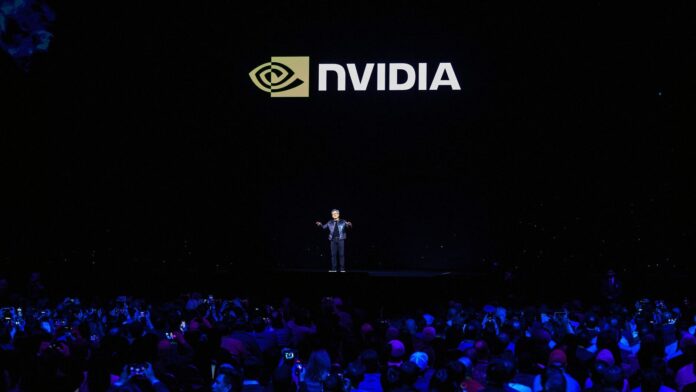During every gold rush in history, the really smart investors have put their money into picks, shovels, and mining equipment instead of trying their luck digging for gold. In the 21st century rush to develop AI, the smartest investors have backed this chip-design giant, elevating Nvidia to the status of the world’s most-valuable company.
Nvidia’s rise has been meteoric. When OpenAI made its ChatGPT conversational AI tool available to the common user in November 2022, Nvidia had an annual revenue of $26.9 billion and $4.3 billion in net profit. In 2023, as many tech companies focussed on developing AI models, Nvidia’s revenue jumped to $60.8 billion and its net profit to $29.7 billion.
In May 2023, Nvidia’s market capitalisation crossed $1 trillion for the first time, and has tripled in the 13 months since. Analysts expect the US company’s revenue to double again in 2024, and to hit $160 billion by 2026. That is incredible growth backed by strong margins.
Nvidia’s corporate culture is worth mentioning. For one, it has fewer than 30,000 employees, which pales in comparison with other trillion-dollar giants. Microsoft has about 220,000 employees, Apple about 161,000, and Google about 180,000. Nvidia’s work culture is driven by desperation. Its chief executive Jensen Huang used to start every presentation with a warning: “Our company is 30 days from going out of business.”
Nvidia is the world’s most famous chipmaker, but it doesn’t actually make chips. It designs them and gets them fabricated by contract manufacturers. It has a stranglehold on the gaming industry, being present in over 80% of game devices. It also has a near-monopoly in high-end AI-related systems and research and development. Some of its AI-capable chips are sold for about $100,000 and resold at huge premiums. Nvidia has a big presence in crypto-mining as well.
Nvidia’s lead in graphics processing units—or GPUs, which are chiefly used in image processing, video games, AI, and crypto-mining—originated with its focus on the gaming industry, where it has a significant R&D lead over its rivals.
GPUs run in conjunction with central processing units, or CPUs, where Intel Corp. and Advanced Micro Devices Inc. (AMD) are bigger players than Nvidia. But GPUs do the heavy lifting in terms of the intensive number-crunching required to render images, run AI algorithms, and solve the mathematical puzzles involved in crypto-mining.
Apart from supplying chips, Nvidia also has an enormous number of global partnerships with companies, institutions, and research labs working in AI. It also has a big presence in India; partnerships with the Indian government-owned National Informatics Centre (NIC), with several of the premier Indian Institutes of Technology (IITs), and various companies including Tata Group, Reliance Group, and Infosys Ltd.
Nvidia is setting up AI data centres in India with Tata and Reliance, and its Mumbai-based partner Yotta Data Services has set up a state-of-the-art facility at Gujarat International Finance Tec-City, or GIFT City.
Nvidia is partnering with IIT-Bombay, IIT-Jodhpur, and Thapar Institute for healthcare and medical research, with Infosys for developing enterprise solutions, with IIT-Hyderabad for R&D in agriculture and transport solutions, and with NIC for e-governance solutions.
In each case, Nvidia brings the infrastructure and hardware to the table, and seeks ways to develop optimised solutions with its partners.
All this should help bridge the gap in AI-capable infrastructure in India as Nvidia brings in its supercomputing Grace Hopper chips and its MGX-server cloud systems. CEO Huang has said he expects India will become a global AI powerhouse.
There is, however, one potential cloud on the horizon of this sunrise industry. Nvidia’s massive valuations and sensational growth have arisen from its monopoly in cutting-edge AI. That monopoly developed naturally from its decades of R&D in image-rendering GPUs. It makes Nvidia an indispensable part of high-end AI projects, but that represents a possible danger.
If Nvidia has any sort of problem, global AI development could run into a supply bottleneck. Even now, Nvidia’s chips are in short supply. Market forces will certainly lead to competition in this area. Chip designers will be looking for ways to close the gap in terms of design capabilities, and eventually, there will be comparable chips from other manufacturers. But until there are credible alternatives to Nvidia’s superchips, this could be a source of concern.
One could argue that Intel and AMD already provide credible alternatives. But Nvidia’s proprietary software platform makes it difficult for its customers to jump ship, since more than 4 million global developers rely on it to build AI and other apps.
That said, the Unified Acceleration Foundation was established in September with Intel, Qualcomm, Samsung, and VMware among its members to prevent AI developers from building apps specifically for one vendor’s GPUs. If successful, this may break Nvidia’s stranglehold.
Until that happens, Nvidia remains an indispensable link in the AI supply chain.
#Nvidias #nearmonopoly #status #dangerous #industry
